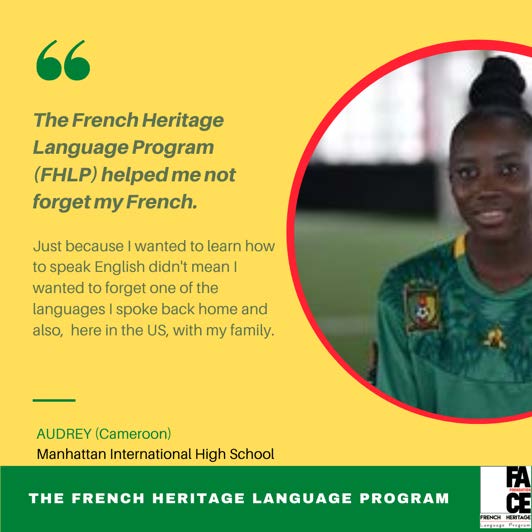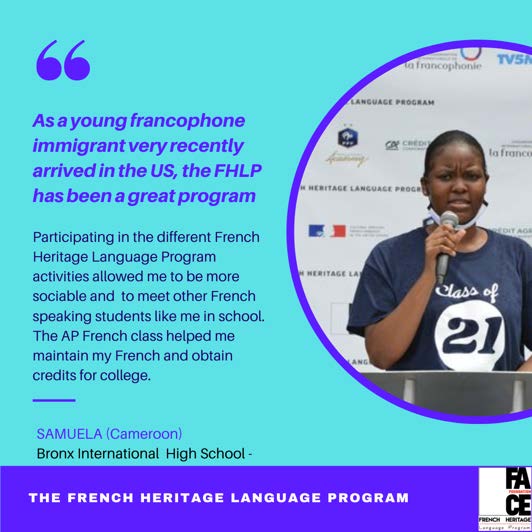


Community-Based Heritage Language Schools (CBHL)
Languages:
French
Part of a larger non-profit organization
The French Heritage Language Program
New York, New York 10075
Making French an Asset for New Americans. Institute Background
With an expected 800 million French speakers in the world by 2050, and 83% of them living in Africa, French is not only a fast-growing international language, it is an increasingly multicultural language that can only be an asset to the future of our students. For many of these French speakers, maintaining this first or second language is often a challenge, especially for new immigrants and disadvantaged families. Because they are focused on English acquisition, our students tend to lose their French very quickly when they arrive in the US. The French Heritage Language Program was created to prevent this loss and foster native language use through French AP classes and afterschool programs in French.
Today, the program is present in 4 of the city’s 5 boroughs, and offers workshops in 10 schools within the Internationals Network for Public Schools, in the Bronx, Brooklyn and Manhattan. An average of more than 200 NYC students now partake in the FHLP activities every year. Moreover, the program’s success in New York has led to expanding classes in other states and including Massachusetts, Maine and Florida where it serves Americans with francophone descent and the Haïtian community.
- Access
- Excellence
Improve Access for all learners in more languages
Percentage of types Students
Heritage Language Learners 100%
Multilingual Learners 100%
Learners who speak a language that is linguistically related to the target language %
Learners who speak a language that is culturally (but not linguistically) related to the target language %
Types of language learners are enrolled
- People of Color
- Heritage language learners (second generation or more)
- Recent immigrants
- Refugees
- English Language Learners
- Economically disadvantaged students
Programs available in your school
- Classes with age-appropriate instruction for different age groups
How do the programs identified above meet the needs of learners of different ages in your school
In New York, we exclusively serve French speaking high schoolers very recently arrived in monolingual schools in the US. Previously schooled in french, they no longer have access to instruction in French and risk losing their linguistic skills and even sometimes, the connection to the language. We specifically serve them by focusing on their heritage, exposing them to formal registers, honing their writing skills and emphasizing how French can be an asset through the AP and the Seal of Biliteracy. We do that through AP classes, after school classes, AP classes and intensive workshops and assisting students to present the Seal of Biliteracy.
What additional activities do you implement at your school to attract and maintain enrollment of students in different groups
All of our activities focus on the importance of keeping one's languages to stay connected to one's roots, the opportunities it brings and on the marketability of being bilingual: field trips, meetings with authors and artists, exchange programs with other French speaking students (from French high schools or American colleges).
Main reasons students attend your school
- To connect with their heritage in a meaningful way
- To gain literacy in the language, in addition to oral communication skills
- To communicate with relatives in the home country
- To communicate with relatives or others in the language community in the U.S.
- To learn and use a language that is not offered in high school
- To earn credits for high school or university studies in the U.S.
- To gain bilingual proficiency for future professional use
Do you offer different pathways of study and engagement to align with the interests and goals of the learners in your school?
When the schools allow it, we offer two different programs: AP classes heavily focused on preparing the AP exam and a separate after school club.
How does your school strive to provide incentives for students to enroll in the language programs?
- Community and/or parent outreach
- Financial support
- Community functions (e.g. culture events, clubs, etc.)
- Travel opportunities
Different types of classes meet the needs of students
Offering separate French classes to Heritage speakers allow the teachers to tailor instruction to their specific linguistic needs, foster a sense of community and address social emotional needs that wouldn't necessarily be addressed in a traditional classroom.
Types of instructional formats your school offer
- In-person
How the instructional formats available at your school enable learners from different geographical areas and other distance-related constraints to receive instruction
Since COVID, we've started offering the AP French workshops offered during the school breaks online to allow as many students as possible to attend.
We've also led a few online workshops to work with schools outside of New York.
Please describe other ways in which your school excels with respect to this factor.
Online classes were done out of necessity during the pandemic; otherwise, we don't really have a virtual model partly because our students seek the programs to make connections, make friends and form a community within their schools.
What are the main sources of financial support for your school
- Home/heritage country
- Private donations from individuals
- Private donations from businesses
- Fundraising events
Does your school offer financial assistance to students?
Yes
How important is the impact of the financial assistance on student enrollment at your school
5
Which of these common competing commitments faced by the learners most negatively impact student enrollment and/or attendance
Name
After-school activities in the mainstream schoo
Homework and other academic pursuits
Extra-curricular activities (sports, music, hobbies)
Religious obligations
Family obligations
Work
Field name
Attendance
Yes
Yes
Yes
No
Yes
Yes
Yes
Enrollment
Yes
Yes
Yes
No
No
No
Yes
How has your school been able to accommodate your students’ competing commitments so that they can attend your school?
The attendance policy is flexible to allow students with competing commitments to come when they can, which means not every week.
How has your school been able to accommodate your students’ competing commitments so that they can attend your school?
The attendance policy is flexible to allow students with competing commitments to come when they can, which means not every week.
Does your school provide information to parents and other stakeholders about essential school information?
Yes
What are the most effective communications methods with parents and stakeholders?
Our different social media channels allow us to interact with our communities.
The newsletter is another medium.
This is our biggest area for improvement; because our programs happen at schools as an afterschool program and students are old enough to make their own decisions about enrollment, we have very little contact with the parents.
We do send them informations and release forms about events we organize.
Does your school communicate with the community at large about events and other information?
Yes
Please describe any educational and cultural activities, seasonal events, as well as other programs and opportunities that your school makes available to the community at large.
Cultural events.
Annual end of the year celebration.
Fundraising events.
List the percentage of students by age group
PreK-K students %
High school students (grades 9-12) 100 %
Excellence through transparency and accountability
Curriculum and instruction
- Curriculum and instruction that build on the linguistic skills and cultural knowledge that learners bring to the classroom
Outcomes
- The opportunity for students outside the formal education system to earn Seals of Biliteracy or other recognition of bilingual and biliteracy ability
Professional Development
- Provision of ongoing professional development for educators and other personnel
- Regular faculty meetings and opportunities to work in professional clusters
Vision, Strategic Planning, and Priorities
- A publicized vision statement, strategic plan, and priorities for serving learners from immigrant, refugee, heritage, as well as other underserved students from outside these communities interested in learning an additional language/languages
Transparency, Accountability, and Outreach
- Strategic collaborations with organizations and initiatives outside of the language education community (e.g., business, government, and NGOs) in order to support and advance the aims of the CBHLS
Institution Information
Year School was Established
2005
Languages taught at your school
French
After-school Classes
Number of weeks per year: 30
Number of hours per week: 1
Average Number of Students
200
Average Number of Teachers
5
Summer Camps
Number of weeks per year: 2
Number of hours per week: 25
